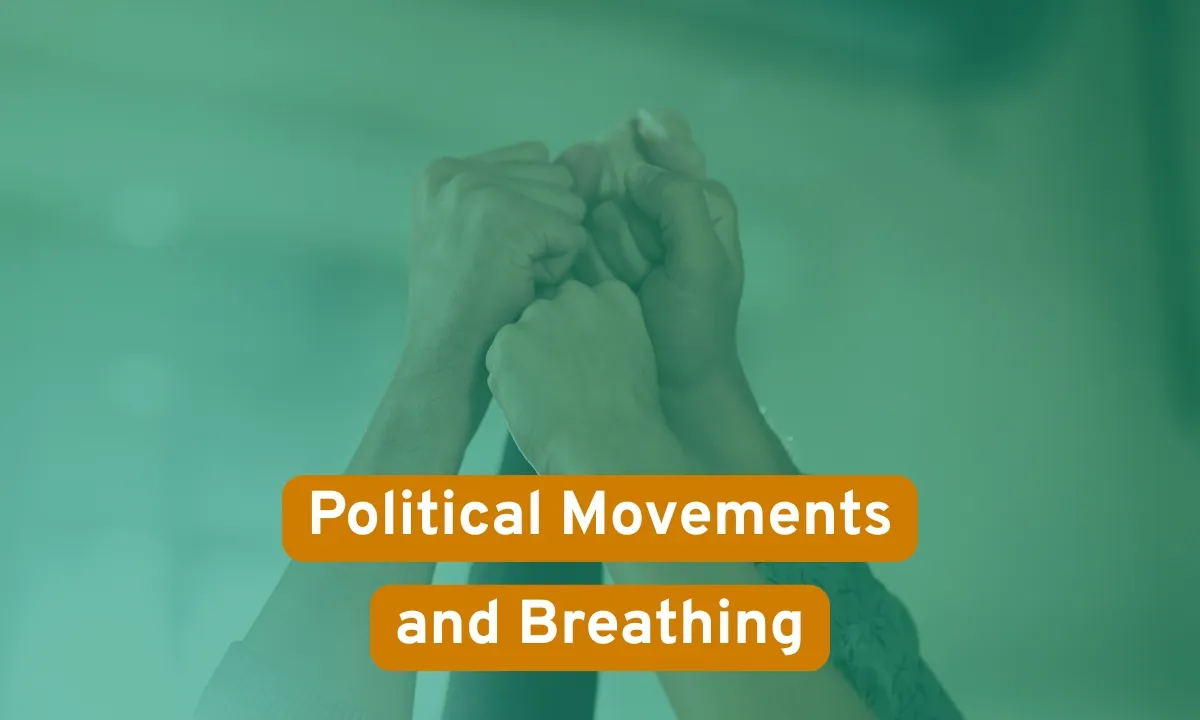Political Movements and Breathing
Political movements show us how marginalized groups envision alternative futures and challenge dominant power structures.

Political movements show us how marginalized groups envision alternative futures and challenge dominant power structures. Scholars have consistently reported on how these movements express demands for justice, reimagine societal relations, and articulate critiques of existing systems, and presenting diverse pathways toward transformation across cultural, spatial, and temporal contexts (McGregor, Whitaker, & Sritharan, 2020; Tavolari, 2020; Durham, 2023).
For anthropology, this means that political movements are not only subjects of analysis but also critical sites where power dynamics and social change intersect. These movement give anthropologists valuable insights into how marginalized groups use collective action, cultural expression, and lived experience to challenge dominant systems and imagine alternative futures. Studying these movements offers anthropology the chance to engage more deeply with issues of justice, inequality, and transformation, which only expands its relevance in contemporary global struggles.
Environmental Justice Movements
Political movements form out of needs. For example, environmental movements are about fighting slow violence, as Rob Nixon’s research has shown (2013). In anthropology, they are understood as socioculturally embedded struggles that connect ecological concerns with social justice. These movements usually highlight how communities resist environmental degradation through locally grounded knowledge, relational worldviews, and critiques of structural inequalities.
Political movements for Indigenous environmental justice, as understood through anthropology, challenge dominant global systems by centering Indigenous ontologies that recognize the Earth and non-human entities as living beings, demanding transformative change rooted in reciprocal responsibilities, self-determined governance, and relational ethics to address the planetary crisis beyond human-centered solutions (McGregor, Whitaker, & Sritharan, 2020).
In many ways, these perspectives demonstrate how political movements not only respond to immediate threats but also articulate broader visions of justice, sustainability, and relational ways of being in the world.
"Right to the City" Movements
Not very different from overall environmental justice movements, there are local movements that explore how structural inequality in cities makes clean air (and breathing) a privilege for some and a risk for others. Mbembe (2019) explains this phenomenon in terms of necropolitics, where political power is used to control who lives and who dies that tend to result in the systematic marginalization and premature death of certain populations.
Right to the city movements, are often grassroots struggles that reclaim urban space and democratic participation. These efforts challenge spatial injustices and neoliberal urbanism through collective action rooted in everyday experiences and historical inequalities. Political movements invoking the “right to the city,” as anthropologists show, draw from both theory and grassroots struggle to contest urban exclusion, expressing demands for public space, affordable transit, and democratic governance in contexts from Brazil to Turkey, where Lefebvre’s concept is reinterpreted through lived resistance to neoliberal urban transformation (Tavolari, 2020).
These movements are important because they reveal to us how urban space becomes a site of political struggle, where communities confront systemic inequalities and assert their right to shape the environments in which they live.
Racial Justice Movements
While urban environments are often at the center of more contemporary justice movements, political struggules have also always been focused on people. For instance, the racial justice movements are analyzed in anthropology as dynamic efforts to confront systemic racism and inequality. These are movements showing us how marginalized communities mobilize cultural identity, historical memory, and collective action to envision and create more just futures.
Political movements like Black Lives Matter (BLM), as examined through anthropology, futurism research, and critical race theory, reveal how Black resistance movements envision racial justice, expressing both skepticism about structural change and hope for social transformation, highlighting how political movements imagine and shape potential futures amid enduring systems of oppression (Durham, 2023).
Political movements like BLM are centered on race relations but they not only resist oppression but also imagine new cultural and social possibilities. They challenge dominant narratives and reshaping visions of the future.
References
Durham, S. N. (2023). Black lives matter and imagined futures of racial dynamics in the US. Social Movement Studies, 23(4), 537–557. https://doi.org/10.1080/14742837.2023.2204425
Mbembe, A. (2019). Necropolitics. Theory in Forms. Durham, NC: Duke University Press.
McGregor, D., Whitaker, S., & Sritharan, M. (2020). Indigenous environmental justice and sustainability. Current Opinion in Environmental Sustainability, 43, 35–40. https://doi.org/10.1016/j.cosust.2020.01.007
Nixon, R. (2013). Slow Violence and the Environmentalism of the Poor. Cambridge, Mass: Harvard University Press.
Tavolari, B. (2020). The Right to the City: conceptual transformations and urban struggles. Revista Direito e Práxis, 11(1), 470–492. https://doi.org/10.1590/2179-8966/2020/47788
Dr. Nasima Selim is an interdisciplinary scholar trained in medicine, public health and anthropology. She is a breathworker, writer, researcher, and educator. Her books include “Breathing Hearts” (Berghahn 2024), an open-access ethnography, and "Ways of Breathing and Knowing" (Routledge, forthcoming), a volume of 12 interdisciplinary essays she co-edited with Dr. Judith Albrecht.
© NasimaSelim.com - All rights reserved.